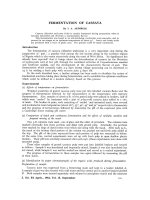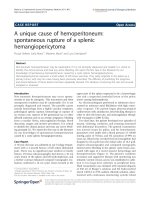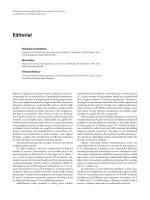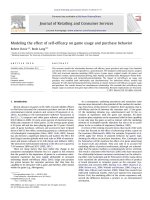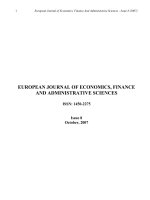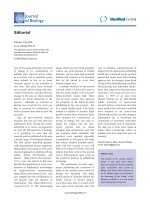Pakistan journal of pharmaceutical sciences (2013) maria
Bạn đang xem bản rút gọn của tài liệu. Xem và tải ngay bản đầy đủ của tài liệu tại đây (401.93 KB, 7 trang )
Isolation and characterization of different strains of Bacillus
licheniformis for the production of commercially significant enzymes
Maria Ghani, Asma Ansari, Afsheen Aman, Rashida Rahmat Zohra, Nadir Naveed Siddiqui
and Shah Ali Ul Qader*
The Karachi Institute of Biotechnology and Genetic Engineering, University of Karachi, Karachi, Pakistan
Abstract: Utilization of highly specific enzymes for various industrial processes and applications has gained huge
momentum in the field of white biotechnology. Selection of a strain by efficient plate-screening method for a specific
purpose has also favored and boosted the isolation of several industrially feasible microorganisms and screening of a
large number of microorganisms is an important step in selecting a potent culture for multipurpose usage. Five new
bacterial isolates of Bacillus licheniformis were discovered from indigenous sources and characterized on the basis of
phylogeny using 16S rDNA gene analysis. Studies on morphological and physiological characteristics showed that these
isolates can easily be cultivated at different temperatures ranging from 30ºC to 55ºC with a wide pH values from 3.0 to
11.0 All these 05 isolates are salt tolerant and can grow even in the presences of high salt concentration ranging from
7.0 to 12.0%. All these predominant isolates of B. licheniformis strains showed significant capability of producing some
of the major industrially important extracellular hydrolytic enzymes including α-amylase, glucoamylase, protease,
pectinase and cellulase in varying titers. All these isolates hold great potential as commercial strains when provided with
optimum fermentation conditions.
Keywords: B. licheniformis, commercial enzymes, amylolytic enzyme, protease, pectinase.
INTRODUCTION
Utilization of bacterial strains specifically from genus
Bacillus is gaining momentum because of their ability to
resist and survive under harsh industrial conditions.
Bacillus licheniformis, Bacillus subtilis and Bacillus
pumilus are some of the strains that are associated with
food spoilage and with a wide range of different clinical
conditions (Turnbull, 1997).
B. licheniformis has proved itself as a multipurpose
organism and has gained popularity along with B. subtilis.
B. licheniformis is most commonly found in soil and as
well as on the feathers of ground dwelling birds (Burtt
and Ichida, 1999). With the rapid advancement in
enzymology and fermentation technology, now
commercially feasible quantities of different industrial
enzymes are being produced by B. licheniformis (De-Boer
et al., 1994). This strain is also used to produce a
polypeptide antibiotic known as bacitracin (Vitkovic and
Sadoff, 1977). B. licheniformis is capable of producing
bacteriocin under aerobic conditions (Kayalvizhi and
Gunasekaran, 2008; Anthony et al., 2009) as well as
under anaerobic conditions against anaerobic
microorganisms (Pattnaik et al., 2001). B. licheniformis in
addition is a frequent contaminant of various industrial
processes (Pirttijarvi et al., 2000).
Although this organism is exploited industrially for the
large-scale production of various enzymes, but it’s
generally regarded as safe (GRAS) status is still a subject
of debate (Salkinoja et al., 1999). This organism has been
reported to produce some of the most important
commercial enzymes including α-amylase, alkaline
protease, keratinase and β-mannanase (Zhang, et al.,
2002; Feng et al., 2003; Hmidet et al., 2009). It has been
reported that B. licheniformis 749/C is a producer of
multiple forms of β- lactamase (Lampen et al., 1980) and
similarly another isolate BAS50 which was previously
isolated from a petroleum reservoir at a depth of 1,500
meters, produces a lipopeptide surfactant (Yakimovet al.,
1995). Most recently this organism has shown the ability
to synthesize gold nanocubes and in broad prospect this
isolate can be manipulated genetically for the synthesis of
nanoparticles with tailored properties (Kalishwaralal et
al., 2009).
Keeping the significance of multiple uses of Bacillus
licheniformis in view, present study was designed to
isolate and screen various strains from indigenous sources
for the production of commercially important enzymes.
MATERIALS AND METHODS
Isolation of bacteria
Soil samples (1.0g) from vegetative field were collected
aseptically and suspended in 100 ml of sterile water.
Diluted sample was transferred in multiple flasks
containing nutrient broth medium and incubated at 37ºC
for 24 to 72 hours. After appearance of growth, a loop full
of bacterial culture was then streaked onto nutrient agar
medium and again incubated at 37ºC for 24 to 48 hours.
*Corresponding author: e-mail:
Pak. J. Pharm. Sci., Vol.26, No.4, July 2013, pp.691-697
691
Isolation and characterization of different strains of Bacillus
Pak. J. Pharm. Sci., Vol.26, No.4, July 2013, pp.691-697
692
From different agar plates, isolated colonies were serially
diluted and sample (0.1 ml) from last three dilutions were
transferred into homologous medium and incubated at
37ºC for 24 hours. Some of the sterile nutrient agar plates
were exposed to air for 30 minutes in order to isolate
microbial cultures from environment. The above
mentioned procedure for isolation was followed. All
morphologically contrasting colonies were purified by
repeated streaking. Identification of the genus was based
on morphological and biochemical characteristics for
Bacillus species. All the tests were performed on liquid
cultures in late-logarithmic phase.
16S rDNA gene analysis and sequencing
Extraction of DNA and sequencing of 16S RDNA gene
was performed by the method as described by Asma et al.
(2012). Primers and PCR conditions were also same as
described previously.
Screening of isolates for the production of alpha-
amylase, protease, pectinase and cellulase
Each isolate was screened for the production of different
enzymes. For the screening of alpha-amylase activity, all
the five isolates of B. licheniformis were grown on 0.5%
starch agar plates and incubated at 37ºC for 24 hours.
After incubation the plates were flooded with iodine-
potassium iodide solution for alpha amylase activity
(Teodoro and Martins, 2000; Qader et al., 2006).
Screening for protease activity was performed by growing
the isolates on 0.1% casein agar plates at 37ºC for 24
hours (Bjorklind and Arvidson, 1977). For visualization
of the clear zones of activity around the growing culture
the plates were flooded with 0.1 % Coomassie brilliant
blue R250 followed by destaining using 40% methanol
and 10% acetic acid.
Pectinase activity of the culture was evaluated by growing
the bacterial strains in a medium containing 0.25% pectin
(Soares et al., 1999). All the isolates were grown at 37ºC
for 24 hours and activity zones were detected using
iodine-potassium iodide solution (1.0g iodine, 5.0g
potassium iodide in 330 ml deionized water) (Fernandes-
Salomao et al., 1996).
The selected isolates were grown for 24 hours in a
medium containing 1.0% carboxymethyl cellulose
(CMC). Hydrolysis of CMC by cellulase enzyme was
verified by staining the plates with Congo-Red solution
(0.1%) followed by washing with 1M solution of NaCl to
intensify the zones (Ramesh et al., 2008).
Production medium and assay procedure of alpha-
amylase, glucoamylase, protease and pectinase activities
of the isolates
All the cultures were grown at 37°C for 48 hours for the
production of alpha-amylase and glucoamylase in the
medium containing (g L
-1
): starch, 15.0; yeast extract,
10.0; peptone, 10.0; MgSO
4
.7H
2
O, 0.5; K
2
HPO
4
, 0.1;
CaCl
2
, 0.01 (pH 7.5). enzyme activity of alpha-amylase
was estimated using 1.0 % soluble starch as a substrate
and the reducing sugar released as maltose equivalent was
detected by 3,5-dinitrosalicyclic acid (DNS) method
(Miller, 1959). The unit of alpha-amylase is defined as the
amount of enzyme which liberates 1.0 μmol of maltose
per minute at 50°C in phosphate buffer of pH 7.5 For the
estimation of glucoamylase activity, 1.5% soluble starch
was used as substrate and was determined by the increase
in glucose that was released after the digestion of starch
under standard assay conditions. Glucose was measured
by glucose oxidase and peroxidase method (Bergmeyer
and Bernt, 1974). One unit of glucoamylase activity is
defined as the amount of enzyme that liberates 1.0 µmole
of glucose at 45°C in potassium phosphate buffer of pH
7.0.
For the production of protease the cultures were grown at
37°C for 24 hours in the medium containing (g L
-1
): yeast
extract, 5.0; peptone, 5.0; dextrose, 30.0; K
2
HPO
4
, 0.1;
CaCl
2
, 0.01 (pH 7.0). For protease estimation, the method
described by Anson (1938) was followed with slight
modifications. Crude enzyme (0.25 ml) was incubated
with 1.0 ml of substrate (0.5 % casein in 50 mM Tris
buffer, pH 8.5). The reaction was stopped using 110 mM
TCA (Trichloroacetic acid). The reaction mixture was
centrifuged at 1000 rpm for 10 minutes and was detected
for the presence of tyrosine residues as described by Folin
and Ciocalteu (1927). Unit activity of protease is defined
as the amount of enzyme that hydrolyzes casein to
produce color that is equivalent to 1.0 µmol of tyrosine
per minute at pH 7.0 at 40°C.
Pectinase was produced at 37°C for 24 hours in a medium
containing (g L
-1
): pectin, 5.0; yeast extract, 5.0;
ammonium sulphate, 2.5; K
2
HPO
4
2.5; KH
2
PO
4
, 2.0 (pH
7.5). Pectinase activity was assayed in terms of
polygalacturonase activity using DNS (Miller, 1959). The
reducing sugar released as galacturonic acid was detected
using 0.25 % citrus pectin as substrate in the assay. One
unit of pectinase activity is defined as the amount of
enzyme required to release one µmole of galacturonic
acid per minute at 50°C in phosphate buffer (pH 7.0).
Cellulase activity was not quantified but only screened for
enzyme production. The values presented in all the tables
are mean of replicate results with p-value of <0.005 and
standard deviation of ± 2%.
RESULTS
In the current study thirty five bacterial strains belonging
to genus Bacillus were isolated and purified from the
mixed culture obtained from the vegetative soil field and
environment samples. Among them only 05 isolates were
identified as Bacillus licheniformis on the basis of
Maria Ghani et al.
Fig. 1: Microscopic characteristics of B. licheniformis.
Key: A, KIBGE-IB1; B, KIBGE-IB2; C, KIBGE-IB3; D, KIBGE-IB4; E, KIBGE-IB5.
Table 1 : Morphological, physiological and biochemical characteristics of Bacillus licheniformis.
Characteristics of Bacillus licheniformis
Pak. J. Pharm. Sci., Vol.26, No.4, July 2013, pp.691-697
693
phenotypic features. Chemotaxonomic characteristics
were further confirmed by 16S rDNA analysis.
Microscopic characteristics of all the five predominant
isolates revealed that all of them are rod-shaped Gram-
positive and spore forming organism with varying cell
size (fig. 1). All the isolates were aerobes or facultative
anaerobes in nature, with a wide diversity in physiological
properties, particularly with respect to temperature for
growth, pH and salt concentration. Main physicochemical
properties of these 05 isolates and their cultivation
features on various media are summarized in table 1.
Assimilation of different carbohydrates is also presented.
Phylogenies of the bacterial isolates
Fig. 2 illustrates the purified PCR product of all the 05
isolates for 16S rDNA. The bands visualized on 1.0 %
agarose gel showed the sequence size of about 1500 bp.
16S rDNA sequences for all the five isolates of B.
Parameters
KIBGE-IB1 KIBGE-IB2 KIBGE-IB3 KIBGE-IB4 KIBGE-IB5
GenBank Accession GU216258 GU216259 GU216260 GU216261 GU216262
Colony Morphology Large opaque
adherent
irregular edges
Large opaque
adherent
irregular edges
Large opaque
adherent
irregular edges
Large opaque
adherent
irregular edges
Large opaque
adherent
irregular edges
Gram Reaction Positive Positive Positive Positive Positive
Cell Morphology Short rods in
chains
Rods in chains Rods in chains Large rods Large rods
Spore Formation + + + + +
Catalase + + + + +
Urease + + + + +
Nitrate Reduction + + + + +
Citrate Utilization + + + + +
NaCl (%) 7-10 7-12 7-12 7-12 7-12
Growth Temperature 30°-55°C 30°-55°C 30°-55°C 30°-55°C 30°-55°C
Growth pH 3-10 3-10 4-11 4-11 4-11
Growth on
SDA
Nutrient broth
Starch agar
Skimmed milk
Casein agar
Pectin agar
+
+
+
+
+
+
+
+
+
+
+
+
+
+
+
+
+
+
+
+
+
+
+
+
+
+
+
+
+
+
Saccharide utilization
Glucose
+
+
+
+
Sucrose
Maltose
Mannose
Lactose
Xylose
+
+
+
+
–
–
–
–
+
+
+
+
–
–
+
+
+
+
–
–
+
+
+
+
–
–
Isolation and characterization of different strains of Bacillus
licheniformis were used to generate the phylogenetic tree
(fig. 3). The isolates received the following accession
numbers: GU216258, GU216259, GU216260, GU216261
and GU216262 for B. licheniformis KIBGE-IB1, B.
licheniformis KIBGE-IB2, B. licheniformis KIBGE-IB3,
B. licheniformis KIBGE-IB4 and B. licheniformis
KIBGE-IB5, respectively.
Pak. J. Pharm. Sci., Vol.26, No.4, July 2013, pp.691-697
694
Fig. 2: Agarose gel electrophoresis of purified PCR
product for 16S rDNA analysis.
Key: M, Marker (1Kb); 1, KIBGE-IB1; 2, KIBGE-IB2; 3,
KIBGE-IB3; 4, KIBGE-IB4; 5, KIBGE-IB5
Fig. 3: Phylogenetic tree constructed based on 16S rDNA
gene sequence analysis from the isolates obtained from
Karachi, Pakistan with reference sequences available at
NCBI through BLAST analysis. Sequences highlighted
are from the current study.
Screening for production of industrial enzymes
All the isolates were screened for the production of
different enzymes. Figs. 4, 5, 6 and 7 present the data for
screening of alpha-amylase, protease, pectinase and
cellulase, respectively. It was observed that the clearing
zone for each isolate in the presence of specific substrate
was different for all the enzymes representing that all of
them are competent of producing these enzymes but with
varying titers.
DISCUSSION
Among several organisms, bacteria have now become the
choice of selection for various industrial processes. One
of the main reasons is that they can be genetically
modified to produce the desired activity and minimize the
undesired products. Screening of a large number of
microorganisms is an important step in selecting a highly
potent microbial culture for multipurpose utilization.
Many studies have been conducted previously in order to
search and select new bacterial isolates that can substitute
fungi by bacterial isolates for the production of various
enzymes at industrial scale. Current study is an attempt to
isolate potent bacterial culture especially B. licheniformis
that has the capability of producing multiple enzymes.
Along with the constitutive enzymes produced by these
bacterial isolates, they could also be able to produce some
of the inducible enzymes when specific substrates are
used. In this study the main focus was to isolate Bacillus
species because they are considered as attractive hosts for
producing heterologous enzymes and they can be easily
genetically modified and transformed. Secondly, they
have an enormous potential to secrete their own proteins
into an extracellular medium.
1500bp
Bacterial isolates obtained and selected in the present
study showed a prokaryotic diversityamong the microbial
community and belongs to the phylum Firmicutes.
Among thirty five (35) bacterial strains which belonged to
genus Bacillus, only five (05) isolates were identified as
B. licheniformis on the basis of taxonomic characteristics.
They were further confirmed by 16S rDNA sequence
analysis. The sequences for the closest neighbors were
used for constructing phylogenetic tree. Total forty
sequences available in the NCBI Gen Bank database were
aligned and it was found that Bacillus licheniformis
KIBGE-IB1, IB3 and IB4 are clustered in one group and
are closely related to B. licheniformis group. However,
IB2 and IB5 are closely related to previously isolated
Bacillus subtilis (GU576479) and (GU586140),
respectively (fig. 3).
All the isolates were screened for the production of
different enzymes and all of them were capable to
produce various enzymes in the presence of specific
substrate. Initially plate-screening method was used for
this purpose. When these isolates were grown under
specific condition with specific substrates they showed
noticeable clearing zones around their colonies on the
agar plates. They showed the capability of producing
alpha-amylase, protease, pectinase and cellulase. All of
these enzymes have a great utility in various industries.
The screening method using starch is a general qualitative
method for the entire amylolytic enzymes, hence it was
not possible to screen for glucoamylase. After
confirmation of the enzymes by different screening
methods, they were quantified using specific assay
Maria Ghani et al.
Table 2 : Production of different enzymes by various isolates of Bacillus licheniformis
B. licheniformis Alpha-Amylase (U/mg) Glucoamylase (U/mg) Protease (U/mg)
Pak. J. Pharm. Sci., Vol.26, No.4, July 2013, pp.691-697
695
methods under standard conditions. Among all the
isolates, KIBGE-IB4 and KIBGE-IB3 showed maximum
alpha-amylase and glucoamylase activities, respectively
(table 2). However, it is a possibility that their enzyme
production capability will increase after complete
optimization of various physical and chemical parameters.
Pectinase (U/mg)
KIBGE-IB1 2621±52 174±3.50 740±14.8 240±4.80
KIBGE-IB2 1328±26 86±1.70 1950±39.0 358±7.16
KIBGE-IB3 2783±55 797±15.9 1025±20.5 620±12.4
KIBGE-IB4 3250±65 35±0.70 650±13.0 591±11.8
KIBGE-IB5 2567±51 72±1.44 598±11.9 270±5.40
Standard deviation, ±2%; p-value, <0.005; n꞊3.
Fig. 4: Screening for alpha-amylase production by different strains of B. licheniformis.
Key: A, KIBGE-IB1; B, KIBGE-IB2; C, KIBGE-IB3; D, KIBGE-IB4; E, KIBGE-IB5.
Fig. 5: Screening for protease production by different strains of B. licheniformis.
Key: A, KIBGE-IB1; B, KIBGE IB2; C, KIBGE-IB3; D, KIBGE-IB4; E, KIBGE-IB5.
Fig. 6: Screening for pectinase production by different strains of B. licheniformis.
Key: A, KIBGE-IB1; B, KIBGE-IB2; C, KIBGE-IB3; D, KIBGE-IB4; E, KIBGE-IB5.
Fig. 7: Screening for cellulase production by different strains of B. licheniformis.
Key: A, KIBGE-IB1; B, KIBGE-IB2; C, KIBGE-IB3; D, KIBGE-IB4; E, KIBGE-IB5.
Isolation and characterization of different strains of Bacillus
Pak. J. Pharm. Sci., Vol.26, No.4, July 2013, pp.691-697
696
Majority of the currently used industrial enzymes are
hydrolytic in action and are used for the degradation of
various natural substances (El-Enshasy et al., 2008).
Amylolytic enzymes from bacterial strains particularly
alpha-amylase and glucoamylase are currently being used
for various industrial purposes (Soccol et al., 1994;
Soccol et al., 1992). Previously, production of bacterial
alpha-amylases have been genetically improved by
applying a range of strategies based on molecular cloning
tools (Niu et al., 2009) but it is much easier and feasible
to explore new industrial strains and optimize
fermentation conditions as compared to genetic
modifications. Proteases also remains the dominant
enzyme type, because of their extensive uses in different
sectors including food, pharmaceutical and exclusively in
the detergent industries (Kalisz, 1988). B. licheniformis
KIBGE IB1, IB2, IB3, IB4 and IB5 have an immense
ability to grow at wide pH range therefore, proteases
produced by them can be used in the preparation of
biological washing powders because all these strains are
well adapted to alkaline conditions and produce alkaline
proteases. The protease produced by strain KIBGE IB-2
was most active near pH 8.5.
Strains belonging to genus Bacillus have played an
important role in biodegradation and bioconversion of
various macro-molecules particularly pectin. Pectinases is
a group of enzymes that catalyzes the degradation of
pectic polymers present in the plant’s cell wall and can
also be produced by many yeast and fungi. On
commercial scale, fungal pectinases are preferable due to
high enzyme yield. However, the fungal pectinases are not
encouraged to be used for the production of vegetable
purees and other food preparations because the pH values
of these food products are close to physiological pH
(Chesson and Codner, 1978) whereas, fungal pectinases
are mostly active in between 3.0 to 5.5 pH (Ueda et al.,
1982). Cultivation of bacteria for the production of pectin
degrading enzymes having neutral pH values are of great
importance. Neutral pectinases is used in processing of
fruits as well as vegetable nectars and for the
improvement of color during wine production. It is also
used to improve extraction yields of oil from plant tissues
and also for the liquefaction of plant tissues (Stressler,
1971; Bailey and Pessa, 1990). In this study we have
successfully screened various pectinase producing B.
licheniformis strains that produces neutral pectinases. It
was found that the maximum pectinase production was by
B. licheniformis KIBGE IB-3 but as KIBGE IB-4 also
produced nearly the same amount of enzyme therefore, it
has been presumed that these strains can be potential
candidates for the production of pectinase after further
optimization of fermentation conditions.
CONCLUSION
B. licheniformis have the ability to survive under harsh
industrial conditions and the enzymes produced by them
have now replaced several organic and inorganic chemical
processes. Bacterial isolates are currently being used for
the production of different products on large scale as
compared to fungi. Isolation and characterization of
predominant B. licheniformis strains capable of producing
various enzymes was performed. The results
demonstrated that all these newly discovered isolates of
B. licheniformis have great potential for producing high
titers of different extracellular enzymes of commercial
importance. Optimization of growth parameters is of
prime importance in industrial production of enzymes
therefore, it is now underway.
REFERENCES
Ansari A, Aman A, Siddiqui NN, Iqbal S and Qader SA
(2012). Bacteriocin (BAC-IB17): Screening, isolation
and production from Bacillus subtilis KIBGE IB-17.
Pak. J. Pharm. Sci., 25: 195-201.
Anson ML (1938). The estimation of pepsin, trypsin,
papain, and cathepsin with hemoglobin, J. Gen.
Physiol., 22: 79-89.
Anthony T, Rajesh T, Kayalvizhi N and Gunasekaran P
(2009). Influence of medium components and
fermentation conditions on the production of
bacteriocin (s) by Bacillus licheniformis AnBa 9.
Bioresour. Technol., 100: 872-877.
Bailey MJ and Pessa E (1990). Strain and process for
production of polygalacturonase, Enz. Microb.
Technol.,12: 266-271.
Bergmeyer HU and Bernt E (1974). D-Glucose
determination with glucose oxidase and peroxidase, In:
Bergmeyer HU editor, Methods of enzymatic analysis,
2
nd
ed., Weinheim, Verlag Chemie, pp. 1205-1215.
Björklind A and Arvidson S (1977). Occurrence of an
extracellular serineproteinase among Staphylococcus
aureus strains, Acta. Pathol. Microbiol. Scand., 85:
277-280.
Burtt Jr EH and Ichida JM (1999).Occurrence of feather-
degrading Bacilli in the plumage of birds, Auk., 116:
364-372.
Chesson A and Codner RC (1978). The maceration of
vegetable tissue by a strain of Bacillus subtilis, J. Appl.
Microbiol., 44: 347-364.
De-Boer AS, Priest F and Diderichsen B (1994). On the
industrial use of Bacillus licheniformis: A review, Appl.
Microbiol. Biotechnol., 40: 595-598.
El-Enshasy H, Abuoul-Enein A, Helmy S and El-Azaly Y
(2008). Optimization of the industrial production of
alkaline protease by Bacillus licheniformis in different
production scales, Aust. J. Basic Appl. Sci., 2: 583-593.
Feng Y, He Z, Ong SL, Hu J, Zhang Z and Ng WJ (2003).
Optimization of agitation, aeration and temperature
conditions for maximum β-mannanase production,
Enzym Microb Technol., 32: 282-289.
Fernandes-Salomao TM, Amorim ACR, Chaves-Alves
VM, Coelho JLC, Silva DO and Araujo EF (1996).
Maria Ghani et al.
Pak. J. Pharm. Sci., Vol.26, No.4, July 2013, pp.691-697
697
Isolation of pectinases hyper-producing mutants of
Penicillium expansum, Rev. Microbiol., 27: 15-18.
Folin O and Ciocalteu V (1927). On tyrosine and
tryptophane determination in proteins, J. Biol. Chem.,
73: 627-649.
Hmidet N, Ali NE, Haddar A, Kanoun S, Alya SK and
Nasri M (2009). Alkaline proteases and thermostable α-
amylase co-produced by Bacillus licheniformis NH1:
Characterization and potential application as detergent
additive, Biochem. Engineer. J., 47: 71-79.
Kalishwaralal K, Deepak V, Ram KPS and Gurunathan S
(2009). Biological synthesis of gold nanocubes from
Bacillus. licheniformis. Bioresour. Technol., 100: 5356-
5358.
Kalisz HM (1988). Microbial proteases In: Adv. Biochem.
Eng. Biotechnol, Springer-Verlag, Berlin Heidelberg,
36: 1-65.
Kayalvizhi N and Gunasekaran P (2008). Production and
characterization of a low-molecular-weight bacteriocin
from Bacillus licheniformis MKU3 Lett Appl.
Microbiol., 47: 600-607.
Lampen JO, Nielsen JBK, Izui K and Caulfield MP
(1980). Bacillus licheniformis beta-lactamases:
Multiple forms and their roles, Philos. Trans. R. Soc.
Lond. B. Biol. Sci., 289: 345-348.
Miller GL (1959). Use of dinitrosalicylic acid reagent for
determination of reducing sugar, Anal Chem., 31: 426-
428.
Niu D, Zuo Z, Shi GY and Wang ZX (2009). High yield
recombinant thermostable α-amylase production using
an improved Bacillus licheniformis system, Microb.
Cell Fact., 8: 58.
Pattnaik P, Kaushik JK, Grover S and Batish VK (2001).
Purification and characterization of a bacteriocin-like
compound (Lichenin) produced anaerobically by
Bacillus licheniformis isolated from water buffalo, J.
Appl. Microbiol., 91: 636-645.
Pirttijarvi TSM, Andersson MA and Salkinoja-Salonen
MS (2000). Properties of Bacillus cereus and other
bacilli contaminating biomaterial-based industrial
processes, Int. J. Food Microbiol., 60: 231-239.
Qader SA, Bano S, Aman A, Syed N and Azhar A (2006).
Enhanced production and extracellular activity of
commercially important amylolytic enzyme by a newly
isolated strain of bacillus sp AS-1. Turk J. Biochem.,
31: 135-140.
Ramesh CK, Richa S, Hena D, Som D and Arvind GA
(2008). Rapid and easy method for the detection of
microbial cellulases on agar plates using Gram’s
iodine, Curr. Microbiol., 57: 503-507.
Salkinoja-Salonen MS, Vuorio R, Andersson MA,
Kampfer P, Andersson MC, Honkanen-Buzalski T and
Scoging AC (1999). Toxigenic strains of Bacillus
licheniformis related to food poisoning, Appl. Environ.
Microbiol., 65: 4637-4645.
Soares MMCN, Silva R and Gomes E (1999). Screening
of bacterial strains for pectinolytic activity:
Characterization of the polygalacturonase produced by
Bacillus sp. Rev. Microbiol., 30: 299-303.
Soccol CR, Cabrero MA, Roussos S and Raimbault M,
(1992). Selection of Rhizopus for growing on raw
cassava. In: Guerrero R editor. Proceedings of the VI
international symposium on microbial ecology,
Barcelona, pp. 302.
Soccol CR, Marin B, Raimbault M and Lebeault JM
(1994). Breeding and growth of Rhizopus in raw
cassava by solid state fermentation, J. Appl. Microbiol.
Biotechnol., 41: 330-336.
Stressler KD and Joslyn MA (1971). Fruits and vegetable
processing tecnology, West-Port, AVI Publishing Co.
Inc.
Teodoro CES and Martins MLL (2000). Culture
conditions for the production of thermostable amylase
by Bacillus sp. Braz. J. Microbiol., 31: 298-302.
Turnbull P (1997). The role of Bacillus genus in infection,
Culture, 18: 5-8.
Ueda S, Fujio J and Lim JY (1982). Production and some
properties of pectic enzymes from Aspergillus oryzae
A-3 J. Appl. Biochem., 4: 524-532.
Vitković L and Sadoff HL (1977). In vitro production of
bacitracin by proteolysis of vegetative Bacillus
licheniformis cell protein, J. Bacteriol., 131: 897-905.
Yakimov MM, Timmis KN,Wray V and Fredrickson HL
(1995). Characterization of a new lipopeptide
surfactant produced by thermotolerant and halotolerant
subsurface Bacillus licheniformis BAS50 Appl.
Environ. Microbiol., 61: 706-1713.
Zhang J, He M and He Z (2002). Operational and storage
stability of neutral β-mannanase from Bacillus
licheniformis. Biotechnol. Lett., 24: 1611-1613.

